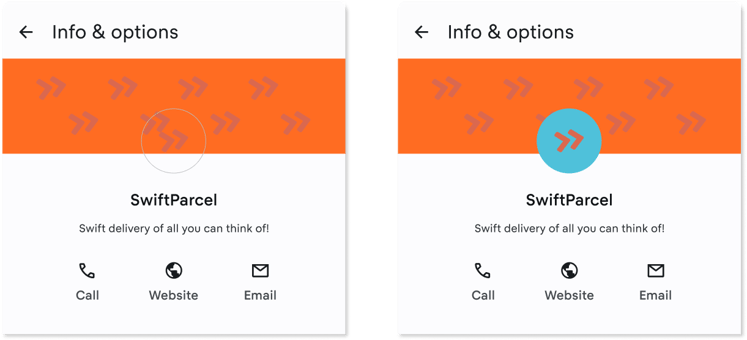Find an RCS service provider
To start sending RCS messages, your business must register with a certified RCS service provider. These providers work with Google and mobile operators to verify your company as a trusted sender, ensuring compliance with industry standards.
This verification process is essential for preventing spam and fraud, as only verified businesses can send RCS messages. It also enhances security by using encryption and verified sender IDs, ensuring safe and reliable communication. Additionally, registering with a trusted provider improves message deliverability and builds user confidence, allowing your business to engage customers effectively through rich, interactive messaging.
Register your business and set up an RBM agent
After choosing an RCS service provider, the next step is to register your business and create an RBM agent—the digital identity customers will see in their messaging apps. An RBM agent represents your brand in RCS messaging, enabling direct, interactive communication with customers.
In the registration process you need to state your business details, technical contact before starting to customise your RBM agent(s).

What you need to provide for the RBM Agent registration
| Field |
Description |
Details |
| Agent Name (Sender ID) |
The name displayed to users when they interact with your agent. Typically, this is the brand name. |
Min 3 / Max 30 characters |
| Agent Description |
A short description or slogan for the brand. |
Min 30 / Max 300 characters |
| Brand color |
The colour of elements in rich content. Choose this to match your brand's colours. |
HEX value with proper contrast ratio for accessibility compliance. Must have a minimum contrast ratio of 4.5:1 against white (e.g., #E91B0C). |
| Agent use case |
OTP, transactional, promotional, or multi-use |
Register multiple agents for different use cases. |
| Logo |
Either upload a file or link to an image url. |
224x224 px SVG or PNG file, max 30 kB. Displayed as a circle. |
| Hero image |
Either upload a file or link to an image url. |
1440x448 px JPEG file, max 120 kB. |
| Phone number |
Your company's primary phone number & label. |
MSISDN format, e.g +4686352600 |
| Website |
URL to landing page, for eg., company website |
|
| Email |
Your company's primary email address & label. |
|
| Privacy and Terms of Use |
URL to your privacy policy and terms of service. |
|
Define your Agent's use case
Selecting the right use case for your RCS agent ensures effective communication and compliance with business messaging guidelines.
- One-time passwords (OTP)
An OTP agent is used for secure authentication, sending one-time passwords required for login, password resets, or transaction verification. This enhances security by providing temporary access codes that protect user accounts and financial transactions.
- Transactional
A transactional agent delivers updates related to a customer’s existing services or purchases. You can send notifications for booking confirmations, delivery statuses, and account updates. Businesses use it to provide essential, real-time information that improves customer experience.
- Promotional
A promotional agent focuses on marketing and sales communication, helping businesses increase engagement and conversions. You can send personalised offers, discounts, and reminders, such as abandoned cart follow-ups, to encourage customer action.
- Multi-use
A multi-use agent can combine transactional, promotional, and conversational messaging within a single interaction. For example, if you send a boarding pass followed by a seat upgrade offer, provide order confirmations alongside promotional deals, or facilitate two-way conversations where customers can ask questions and receive support in real-time. This approach creates a seamless and engaging customer experience.
Each use case serves a distinct purpose and must be applied correctly to ensure compliance, efficiency, and a seamless user experience.
Design your brand profile
Now it’s time to set up your brand profile for RBM, ensuring your messages are instantly recognisable and build customer trust. This involves defining key elements like your business name, logo, and brand color, which will appear in your RCS messages.
Hero Image
When designing your hero image, keep in mind that it will overlap with the logo. To maintain a clean and balanced visual experience, avoid placing critical details where they might be obscured.

Logotype
The logo will be displayed in a circular frame, even if uploaded as a square image. Always preview how it appears in this format and leave ample space around the edges to prevent important details from being cropped. If the logo extends to the edges, parts of it may be cut off, affecting its clarity and recognition.

Optimise images for better visibility
For clear and professional branding, avoid using images with transparent backgrounds. Logos with low contrast may blend into dark mode backgrounds, making them difficult to see. If transparency affects visibility, use a white background to ensure your logo remains clear in all display settings.
Transparency

Light & dark mode

How to register your RCS Business Messaging Agent
Ready to get started with RCS? LEKAB is here to help. After a consultation with our sales team, we’ll send you a link to complete the registration process. With our expertise, we’ll guide you through every step, from registration to successfully integrating RCS into your communication strategy.
Once registered, you’ll be set to send branded, verified RCS messages with rich multimedia, carousels, interactive buttons, and more—enhancing every customer interaction. And if the recipient doesn't yet have an RCS-compatible mobile phone? Then the message will be delivered automatically as a regular SMS - so you'll always get through.
Contact us today, and we’ll assist you in registering your business and starting your journey with RCS messaging right away!






